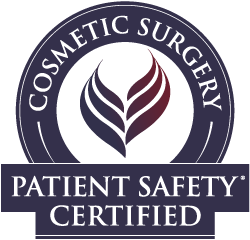Body Lifts for Men
Why Men Consider Body Lift Surgery
Losing a dramatic amount of weight is no easy feat, and you should feel proud of your efforts and confident in your new body. But extreme weight loss, whether achieved through diet and exercise or bariatric surgery, can often leave you with hanging skin that interferes with your confidence and quality of life, making it difficult to celebrate your hard work. For men who have lost a significant amount of weight and are suffering from lost skin elasticity, Bellevue cosmetic surgeon Dr. Alex Sobel offers body lifting procedures that can be an effective way to reshape your body and reduce excess or sagging skin.
A lower body lift can improve the tone and shape of your body to create a firmer and more toned overall appearance. This can help you feel more comfortable in your clothes and allow you to better enjoy the positive effects of weight loss.
- Triple board-certified in general cosmetic surgery, facial cosmetic surgery, and otolaryngology
- 15+ years of experience specializing in cosmetic surgery
- Operates in an on-site accredited surgical suite for patient safety and privacy
- National leader in cosmetic surgery, including as Past President of the American Board of Cosmetic Surgery and the American Academy of Cosmetic Surgery, and as an expert speaker at medical conferences
- Former Seattle Met Top Doctor with hundreds of 5-star patient reviews
How much does a body lift cost in Seattle?
Body lift surgery costs in the Seattle area range from $7,900 – $23,000 depending on the extent of the procedure needed to achieve your desired results. Dr. Sobel will provide you with a personalized quote based on the number of procedures you wish to include in your body lift surgery plan during your consultation. We also offer financing options to make paying for your procedure easier and more convenient for you.
What to Expect from Body Lift Surgery
Body contouring after weight loss may include a number of procedures designed to address your specific concerns. To reduce excess skin on the lower body, a lower body lift may be recommended. This combination of procedures can correct sagging skin on the buttocks, thighs, hips, flanks, and abdomen to highlight underlying muscle tone and decrease amount of leftover skin.
Body Lift Options
Dr. Sobel will work closely with you to tailor your surgical plan to your specific needs and individual anatomy, but body lift surgery typically includes:
- Abdominoplasty, or tummy tuck surgery, to improve the appearance of hanging skin and excess fat on the lower abdomen. This procedures involves tightening underlying abdominal muscles, removing excess skin and small areas of fat, and lifting remaining skin.
- Buttock lift to remove and tighten any extra skin that has gathered around the outer thighs and buttocks. This reduces the appearance of wrinkled or aged-looking skin in the area to create a firmer and smoother appearance.
- Thigh lift to reduce sagging skin on the inner thighs, which can create painful chafing and make physical activity difficult. By removing excess skin and tightening remaining skin, Dr. Sobel can create a slimmer, more pleasing contour to the upper leg.
During your personalized consultation with Dr. Sobel, he will listen to your concerns, evaluate the quality of your skin, and advise you on the best course of action to meet your goals.
- Key Benefits
- Glossary
- Removal of Excess Skin: This procedure effectively removes large amounts of loose, hanging skin that can be a physical and emotional burden.
- Improved Physical Activity A body lift can significantly enhance your ability to move around comfortably, as it removes the excess skin that can hinder physical activity.
- Reduced Skin Irritation: Excess skin can lead to chafing, rashes, and infections. A body lift can alleviate these issues by removing the skin folds where such problems commonly occur.
- Abdominoplasty: Also known as a tummy tuck, a surgical procedure that removes excess skin and fat from the abdomen. Often a component of a lower body lift.
- Anesthesia: Medications used to prevent pain during surgery. In body lift procedures, this can include local, twilight, or general anesthesia.
- Arm Lift (Brachioplasty): A surgical procedure that removes excess skin and fat from the upper arms, typically from the underarm area to the elbow. This procedure is often sought by individuals who have experienced significant weight loss or sagging skin due to aging, resulting in ‘bat wings’. An arm lift is designed to result in tighter, more toned upper arm contours.
- Belt Lipectomy: Another term for a lower body lift, it involves an incision that runs around the entire waistline, resembling a belt.
- Body Contouring: A term for procedures that alter the shape of different areas of the body, including body lifts, liposuction, and tummy tucks.
- Brachioplasty: Also known as an arm lift, a procedure that removes excess skin and fat from the upper arms. Sometimes performed as part of an upper body lift.
- Circumferential Body Lift: A comprehensive body lift procedure that removes excess skin and fat from the entire circumference of the torso, often after significant weight loss.
- Compression Garment: Special clothing worn after a body lift to reduce swelling, support the healing tissues, and help contour the body.
- Drainage Tubes: Tubes placed at the surgical site to drain excess fluid and reduce swelling after a body lift.
- Excess Skin: Skin that has become stretched and does not shrink back after significant weight loss or due to aging. Its removal is a primary goal of body lift surgery.
- Incision: The surgical cuts made during a body lift. The length and pattern of these incisions depend on the amount and location of excess skin to be removed.
- Lower Body Lift: A surgical procedure that targets the abdomen, buttocks, lower back, and thighs to remove excess skin and fat and improve body contours.
- Massive Weight Loss: A significant reduction in body weight, often achieved through bariatric surgery or lifestyle changes. After massive weight loss, individuals may have excess, sagging skin and residual fat deposits that do not respond to exercise or diet, making them potential candidates for body lift procedures. These procedures help to remove excess skin and improve body contours.
- Recovery Period: The time required for healing and recuperation after a body lift, which involves rest and following post-operative care instructions.
- Seroma: A complication where fluid accumulates under the skin after surgery. It’s a risk after extensive procedures like a body lift.
- Skin Elasticity: The ability of the skin to return to its original shape after being stretched. Reduced skin elasticity is a common reason for seeking body lift surgery.
- Thigh Lift: A procedure that reshapes the thighs by reducing excess skin and, in some cases, fat, resulting in smoother skin and more proportionate contours.
- Upper Body Lift: A surgical procedure that targets the breasts, chest, and upper back to remove excess skin and fat and improve contours. It often includes procedures like a mastopexy and brachioplasty.
- Weight Stability: The importance of maintaining a stable weight before undergoing a body lift, as significant weight fluctuations can affect the results.
Why is Body Contouring Different for Men?
Men and women have different anatomies and therefore different body lift needs. Male muscle is often denser than female muscle and male skin can be thicker, which impacts the techniques used to perform body lift surgery. Choosing a surgeon with knowledge and specific experience in male cosmetic surgery is important to the success of your procedure.
“I am very happy with my cosmetic surgery. It has given me a new beginning in my life. It has increased my confidence. Dr. Sobel and his team are amazing. Thank you so much for your skill & talent, Dr. Sobel!
How We Ensure Your Safety During Your Body Lift Procedure

Because body lift surgery is typically quite extensive, it’s critical that patients choose a doctor who operates in a facility with hospital-level safety measures in place. Our private operating suite in Bellevue is accredited by the Washington State Department of Health (WADOH).
How Long Does Recovery Take?
Depending on your chosen procedures, body contouring recovery times may vary. Typically, however, these procedures require significant recovery time. Most patients require four to six weeks of recovery before returning to normal activities. You should not perform excessive movements or lift more than five pounds during the initial healing time. Dr. Sobel will explain all of the important facts about recovery to you so that you can have a safe and effective healing experience.
Frequently Asked Questions about Male Body Lift Surgery
If you have experienced significant weight loss and are unhappy with sagging skin, body lifting procedures can address these issues. Dr. Sobel will work with you to evaluate your specific body lift needs and design a surgical plan especially for you. Contact us today to schedule your personalized consultation.
References »
Herman CK, Hoschander AS, Wong A. Post-Bariatric Body Contouring. Aesthetic Surgery Journal. 2015 Aug;35(6):672-87. doi: 10.1093/asj/sjv008.
ElAbd R, Samargandi OA, AlGhanim K, Alhamad S, Almazeedi S, Williams J, AlSabah S, AlYouha S. Body Contouring Surgery Improves Weight Loss after Bariatric Surgery: A Systematic Review and Meta-Analysis. Aesthetic Plastic Surgery. 2021 Jun;45(3):1064-1075. doi: 10.1007/s00266-020-02016-2.
Reconstructive and Aesthetic Surgeons; Royal College of Surgeons England. National commissioning guidelines: body contouring surgery after massive weight loss. Journal of Plastic, Reconstructive & Aesthetic Surgery. 2014 Aug;67(8):1076-81. doi: 10.1016/j.bjps.2014.04.031.
Soldin M, Mughal M, Al-Hadithy N; Department of Health; British association of Plastic, ElAbd R, Samargandi OA, AlGhanim K, Alhamad S, Almazeedi S, Williams J, AlSabah S, AlYouha S. Body Contouring Surgery Improves Weight Loss after Bariatric Surgery: A Systematic Review and Meta-Analysis. Aesthetic Plastic Surgery. 2021 Jun;45(3):1064-1075. doi: 10.1007/s00266-020-02016-2.
Soldin M, Mughal M, Al-Hadithy N; Department of Health; British association of Plastic, Reconstructive and Aesthetic Surgeons; Royal College of Surgeons England. National commissioning guidelines: body contouring surgery after massive weight loss. Journal of Plastic, Reconstructive & Aesthetic Surgery. 2014 Aug;67(8):1076-81. doi: 10.1016/j.bjps.2014.04.031.
Aldaqal SM, Makhdoum AM, Turki AM, Awan BA, Samargandi OA, Jamjom H. Post-bariatric surgery satisfaction and body-contouring consideration after massive weight loss. North American Journal of Medicine and Science. 2013 Apr;5(4):301-5. doi: 10.4103/1947-2714.110442.
Reviews for Anderson Sobel Cosmetic
![]()
"I am thrilled to share my experience with Dr. Sobel, a highly skilled cosmetic s... read more"
![]()
"I had a great experience with Dr Sobel and his staff. I feel like all my concern... read more"
![]()
"Mi esperiencia a sido muy buena con el doctor Sobel los resultados muy buenos el... read more"

Medically reviewed by Dr. Alexander Sobel — Updated on Oct 23, 2024



